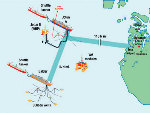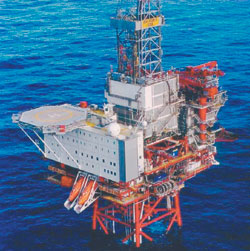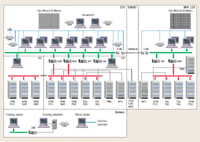Integrated automation solution provides reliability and safety
PRODUCTIONIntegrated automation solution provides reliability and safetyNew, unified systems approach and innovative contracting strategy cut costs, improve safety and increase production efficiencies of North Sea Jotun oil fieldThorstein Thyberg, ExxonMobil; Bjørn Knutsen, Kvaerner Engineering; and Geir Myhre, Honeywell
Overview Jotun oil field, like other North Sea developments, faces strict safety and environmental regulations, as well as increased production demands. Located on the Norwegian Continental Shelf about 110 mi (180 km) west of Haugesund, Norway, Jotun’s three separate structures – Elli, Tau West and Elli South – comprise a single production unit. The field has total recoverable oil reserves of about 200 million bbl oil and a production capacity of 80,000 bopd. Its facilities include a WHP tied back to an FPSO vessel, Fig. 1.
Developed in the late 1990s, Jotun became productive partly because its operator, ExxonMobil, and primary engineering contractor, Kvaerner Engineering, deployed an integrated control / safety system architecture across the field’s WHP and FPSO facilities. The project’s success was aided by a unique contracting strategy that designated a single supply source for all control, safety and marine technologies, and established an integrated project team that improved business. Jotun’s WHP consists of an integrated deck with utilities, wellhead systems, a helideck, support systems and drilling operations. Topside facilities include processing, living quarters, power generation, utility systems, safety and emergency systems, support communication, control, instrumentation and electrical systems, Fig. 2.
The WHP is connected to the FPSO through eight flowlines / umbilical risers. Production operations performed onboard the FPSO include inlet separation, crude oil stabilization and dewatering, gas dehydration, hydrocarbon dewpoint conditioning, sales and lift gas compression, product metering and chemical / water injection systems. First- and second-stage separators, as well as an electrostatic coalescer, are used in the facility’s separation processes. The FPSO’s transfer system incorporates a turret affixed to the seabed that is arranged to accommodate mooring lines; production, test, water injection and service lines; and power and control umbilicals. Signal transferring from FPSO to WHP is handled via a fiber-optic link and high-voltage slip rings installed on the turret. This unique design is the first of its kind in the North Sea and, according to Norwegian authorities, provides a superior alternative to traditional systems. It also significantly cut costs by eliminating need for a control room and related instrumentation for the turret, and by reducing requirements for cabling and additional, costly slip rings. Integrated Project Team Reduces Costs Development of Jotun, which began in early 1997, was aided by a unique contracting strategy that fostered a close working relationship among all project participants. An integrated project team comprising customer, contractor and sub-contractor representatives collaborated at each stage of the development work to ensure cost-effective delivery and implementation of the facility’s automation and safety solutions. From the outset, the integrated project team worked together on tasks ranging from developing project scope, schedules and costs, to planning and estimating work items. Aside from their contributions during early design and engineering phases, team members played a major role in establishing criteria and recommending solutions for process control, safety and information systems. A key aspect of the contracting strategy was selecting a single supply source for Jotun’s integrated control system (ICS), which was a departure from the typical practice of the design contractor procuring individual control / safety system packages from different manufacturers. This new approach involved designating a main instrumentation / control system contractor (Honeywell Inc., Oslo, Norway) to oversee all design, implementation, installation, commissioning and training for Jotun’s ICS, as well as the subsystem information management system, heading control system, load and stability software and other key components. Selecting a main automation contractor in early design phases of the project assured "best-in-class" control solutions. In addition, single-source accountability reduced costs in hardware / software, integration, commissioning, maintenance, spare parts, engineering support and training. Additional, on-going savings were realized as site personnel gained experience with the standardized automation platform and applied their expertise throughout the project. Unified System Improves Safety And Availability An effective automation system is critical to safety and availability of a wellhead platform and FPSO vessel. As mandated by ExxonMobil’s internal safety standards and regulations of the Norwegian Petroleum Directorate (NPD), human lives, process equipment and the environment must be rigorously safeguarded. According to NPD officials, Jotun’s safety and automation system is one of the most technically advanced installations in the North Sea. Secure, reliable operation of the FPSO and wellhead facilities is made possible by deploying control, safety and marine technologies integrated in a uniform hardware platform, Fig. 3. This includes:
Integration of critical systems / subsystems as part of an open, distributed control system (DCS) provides process automation and safety functionality across a common platform throughout the facility. In this architecture, a network interface module provides the communications link between the process network and a universal control network (UCN). Hardwired I/O is interconnected through high-performance process managers (HPMs) residing on the UCN, while the human-machine interface (HMI), higher-level applications and historical functions reside on the process network. The high-performance process managers (HPMs) perform all sequential, regulatory, device and logic control functions. Their deterministic control ensures that control applications function in a consistent, reliable manner. The user-friendly, Windows NT-based HMI includes a wide variety of standard, preconfigured detail displays that can be configured for specific operational scenarios. Operators can maintain their view of process and alarm status while accessing and viewing various process information displays. The "fail-safe" technology used for ESD/F&G not only supports high production availability, but eliminates unnecessary process downtime as well. Approved by the TÜV safety organization, the system provides integrated diagnostics, status and sequence of events via UCN coupling. System modules perform extensive internal self-tests and status indications without need for external diagnostics, and provide "loop monitoring" capabilities that extend diagnostics to gas and flame detectors, manual call points, beacons and other points in the field. In addition, ESD/F&G configuration enables MOS operation directly from operator workstations. Engineers make program changes either on- or off-line and add or remove data transmission lines without upsetting activity on lines already connected. A process history database (PHD) installed on the FPSO continuously retrieves information from process and safety systems. This robust process retrieval system, which stores process variables at 5-sec intervals for up to 10 years, allows operators to archive / retrieve historical process information over an extended period of time. In addition, an advanced application processing platform running Windows NT software performs all load / stability calculations for the FPSO. The ballast / cargo loading advisory package receives ballast and cargo tank level inputs, and assists marine operators in maintaining the FPSO’s stability during loading and offloading operations. System topology. The entire Jotun facility is controlled from a central control room (CCR) onboard the FPSO. The CCR is equipped with six, dual-screen operator stations, as well as a separate console for a heading control system. Single-screen, desktop consoles located in central and local equipment rooms are used for maintenance and engineering. Additionally, an onshore operator station provides FPSO production monitoring and control via satellite communication. To minimize system load and improve signal transmission capabilities, a communication master handles all communication between the ESD/F&G system on the WHP and the FPSO. The link to multiplexer on the turret is dual redundant and also failsafe (certified by Sintef). The multiplexer’s built-in diagnostics monitors the equipment. All ESD/F&G systems are directly linked to the UCN on the wellhead platform, providing time synchronization, enhanced status information, diagnostics, sequence-of-event recording, and peer-to-peer communication with other nodes on the network. Emergency shutdown. Jotun’s advanced ESD system ensures that dangerous process or system conditions do not jeopardize lives, equipment, or damage the environment. It provides operators with proper status information for the process plant over any time period via a serial link to the control system. The system also has a fully fault-tolerant solution (redundant inputs, redundant CPUs and redundant outputs) and employs high-level diagnostics within a well-defined time period to accomplish "risk control by time management." This concept relies on active testing of hardware and software rather than on passive hardware voting. Self-testing is performed on all input / output channels and on other critical functions, including central processing unit (CPU), memory, communications and watchdog operations. The ESD system’s redundant watchdog module monitors CPU memory health, internal voltage and manual ESD functions. If a fault is detected within a fail-safe output channel, a tested secondary output performs necessary partial or full shutdown of the faulty channel. This, in effect, makes the channel a one-out-of-two voter for safety. Fire and gas. Jotun’s redundant F&G system performs timely detection / signaling of escaped hydrocarbon gases and fire. It also provides operators accurate status information for the process plant over any time period, and supplies the sequence-of-event recorder with event information. Upon detection of a confirmed fire (more than one detector in the same area), F&G controls activate the fire water and/or halogen gas systems and trigger sounders / beacons. Because F&G systems are less critical than ESD (not directly involved with production), project engineers use simplex inputs in combination with fully redundant outputs. Unlike the ESD system, the F&G system employs de-energized signals – a necessary approach because "breakage failure" of wiring is not covered by normally energized signals. Coverage of these failures requires application of I/O modules with loop monitoring facilities and single-fault tolerance for activation of external corrective measures, such as fire water pumps, beacons, etc. System "Healthcare" Agreement The integrated automation solution at Jotun will deliver benefits for years thanks to a performance-related "Healthcare" program. A 5-year agreement between ExxonMobil and the automation contractor provides software upgrades, spare parts, and 24-hour standby service as required. Control and safety system performance is supported by a dedicated, on-site engineer who assists the ExxonMobil staff with process tuning, programming, equipment maintenance and other related tasks. Additional, in-depth assistance, such as system upgrades and design of new control functions, is available from the automation contractor’s staff stationed onshore in Norway. Together, these maintenance personnel use various process analysis tools and methodologies to ensure integrated systems onboard the WHP and FPSO perform at an optimum level. The system healthcare program is particularly beneficial for predictive / preventive maintenance. System diagnostic data provide an accurate picture of process conditions and equipment health, and identify poorly performing instrumentation for replacement before an unscheduled process shutdown occurs. Results Impact Economics The innovative, single-source automation contracting strategy and unified control architecture for all wellhead platform and FPSO systems provided significant economic benefits at Jotun. Designation of a main instrumentation and control system contractor for the project, versus traditional contracting methodologies, enabled ExxonMobil to realize many performance advantages and cost savings. Under the terms of the supply agreement, which emphasize "shared risks and shared rewards," the automation contractor assumes greater responsibility for project success. For example, involving the contractor early in the development work helped reduce project design / engineering costs, and simultaneously ensured "best-in-class" control solutions. The advanced transfer solution for the FPSO turret alone netted ExxonMobil more than $1 million in installation / control equipment cost savings. An integrated project team approach encourages close interaction between all participants and allows members to identify and implement numerous cost-saving opportunities, such as:
An integrated control system encompassing all process control, safety and marine technologies allowed for quick start-up of critical WHP/FPSO systems. Control system commissioning of offshore integration between FPSO and WHP was completed in five days and was exceptionally trouble-free. This, in turn, helped ExxonMobil meet its target date for reaching first oil. The ICS also eliminated many spurious shutdowns and reduced costly downtime associated with process "events." Jotun’s record of continuous production uptime has surpassed that of many other comparable facilities in the North Sea. Production uptime for this year is estimated to be >97 %. Finally, the long-term healthcare maintenance agreement enabled ExxonMobil to optimize maintenance of all physical assets on Jotun’s FPSO and wellhead platform. When compared with normal, projected maintenance and spare parts expenditures, the agreement has yielded cost savings of about $100,000 annually. The combination of a unified, facility-wide control solution, and single-source accountability for automation contracting, made Jotun a worthwhile venture for ExxonMobil. The integrated systems philosophy expedited first oil with less project execution risk, and subsequently increased process reliability, improved human safety and enhanced regulatory compliance. The company expects the oil field to be a productive asset for decades to come.
|
||||||||||||||||||||||
- What's new in production (February 2024)
- U.S. operators reduce activity as crude prices plunge (February 2024)
- U.S. producing gas wells increase despite low prices (February 2024)
- U.S. oil and natural gas production hits record highs (February 2024)
- Dallas Fed: E&P activity essentially unchanged; optimism wanes as uncertainty jumps (January 2024)
- Mixed outlook for activity on the UK Continental Shelf (December 2023)





